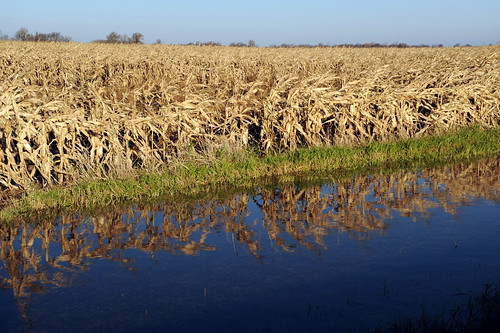 |
| Corn crop in Iowa Photo by Cwwycoff1 on Flickr |
News of environmental damage from biotech crops is a very sensitive issue: the researcher was subject to a barrage of professional criticism from the scientific community quite out of proportion with the limited study she had carried out.
Undaunted, however, Rosi-Marshall has continued her line of investigation, and continues to throw up uncomfortable facts about Bt-toxin in the environment. Her latest published offering concerns just where all the Bt generated by GM maize ends up.
In the major corn-growing states, Iowa, Illinoise and Indiana, 63% of the corn had, by 2009, been genetically transformed to generate 'Cry1Ab' protein throughout the plant. This novel protein is modelled on a toxin produced by the bacterium, Bacillus thuringiensis ('Bt'). It is lethal to European corn-borer larvae, a serious pest in the USA.
Most Cry1Ab in the cobs is removed from the field at harvest, but the rest of the plant is a source of Bt-toxin in the environment. Below ground, the live roots exude Cry1Ab into the soil and the root biomass releases the protein during decomposition. Above ground, 'conservation tillage' is commonly practised: maize debris, along with its Bt-load, is left to rot on the soil surface.
Maize fields in the three states are served by a highly efficient man-made network of drains which receive run-off from the soil surface and draw off excess soil water into tile drains beneath the roots. A system of ditches connected to streams channels the water ultimately into the Mississippi river or the Great Lakes.
Cry1Ab is not a short-lived substance in the environment: it is detectable in the crop debris in GM maize fields after at least seven months post-harvest; and it binds strongly to clay, humic acids and organo-mineral complexes in the soil.
Rosi-Marshall's snap-shot view of where the GM toxin ended up six months after harvest indicated that both Bt-containing particulate matter and leached Bt toxin travel from the field through the waterways to become distributed throughout the landscape:
- 86% of streams had maize leaves, stalks, cobs and husks in them
- 13% of the debris had detectable Cry1AB
- 25% of sites had detectable dissolved Cry1Ab in the water
- 100% of sites within 500 metres of fields which had grown maize during the previous season had detectable Cry1Ab; this extrapolates to 91% of streams in Iowa, Illinois and Indiana.
The Ecological consequences of the waves of Bt-spread after each rainfall are unknown.
OUR COMMENT
There's no reason not to assume that, as the current single-Bt generating crops become obsolete and are replaced by stacked versions generating several different toxins and accumulating several different herbicides, harm to the environment will become exponential due to toxin interactions.
Also, since researchers in Canada have shown that, even at current usage levels, GM-related toxins are ending up inside people, the implications for stacked GM crops could be serious (see GM PESTICIDES INSIDE YOU – April 2011).
Yes, just another few reasons not to grow, buy or eat GM.
SOURCES
- J. L. Tank et al., 2010, occurrence of maize detritus and a transgenic insecticidal protein (Cry1!b) within the stream network of an agricultural landscape, PNAS
- Insecticides from genetically modified corn present in adjacent streams, Cary Institute of Ecosystem Studies, 27.09.10
- Steve Connor, GM maize 'has polluted rivers across the United States', Independent, 28.09.10'
- E. J. Rosi-Marshall et al., 2007, Toxins in transgenic crop by0roducts may affect headwaer stream ecosystems, PNAS
No comments:
Post a Comment
Thanks for your comment. All comments are moderated before they are published.